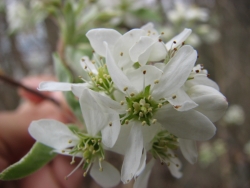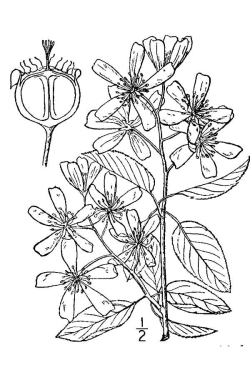Amelanchier canadensis
 |
 |
|
Philipp Franz von Siebold and Joseph Gerhard Zuccarini Plate, Flora Japonica, Sectio Prima (Tafelband), 1870 |
Photo courtesy Renee Brecht |
Britton & Brown |
| Botanical name: | Amelanchier canadensis (L.) Medik.. |
| Common name: | Canada serviceberry, shadbush |
| Group: | diocot |
| Family: | Rosaceae |
| Growth type: | fTree (usually multi-trunked) Shrub |
| Duration: | perennial |
| Origin: | native |
| Plant height: | to 25' |
| Foliage: | deciduous, alternate, simple, downy below with a serrated margin |
| Flower: | 1/2" white, slightly fragrant, in loose racemes of 4 to 10 flowers; 5 petals |
| Flowering time: | April-May; fruits mid June to mid July |
| Habitat: | wet woods; shaded edges, swamps, watersides, coastal marshes |
| Range in New Jersey: | all counties except Warren |
| Heritage ranking, if any: | n/a |
| Distribution: |  |
| Misc. | Fruit is edible. Its wood is good for
tool handles and fishing rods. Stone, 1910, applied Amelanchier intermedia to what is now A. canadensis. He applied A. canadensis to what is now A. borealis. He says of A. intermedia=A. canadensis: "The shad-bushes give the first touch of bloom to the swamps of the coastal plain. Their spikes of white flowers and whitish leaf buds stand out in strong contrast to the somber brown tints that prevail until the general bursting of bud clothes everything with the misty gray-green of early spring, and by that time these pioneer flowers are ready to scatter their white petals like a belated flurry of snow. The bushes then become inconspicuous among the other green shrubbery" (488). |